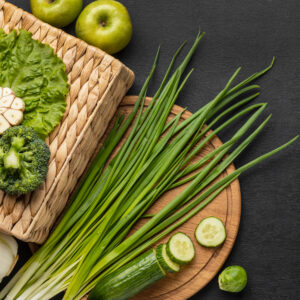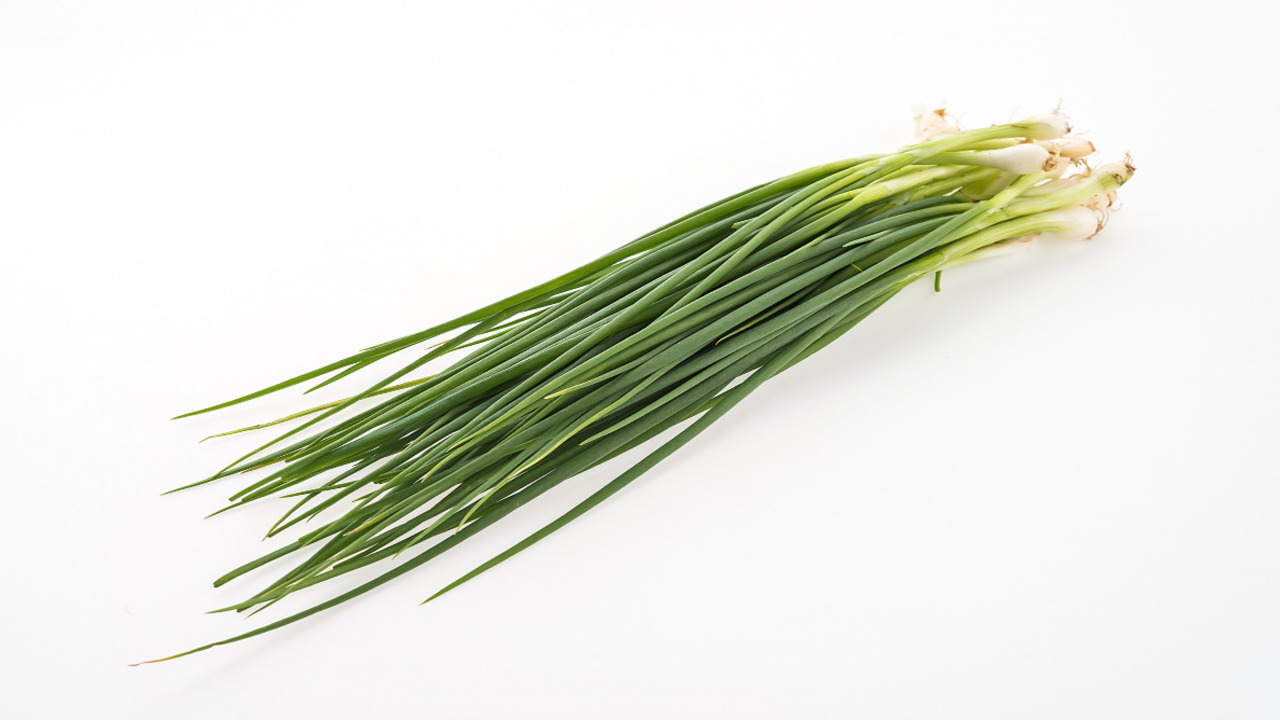Green onion: Sometimes referred to as spring onions or scallions, are a common ingredient in kitchens all around the world. They are an adaptable ingredient in many different recipes because of their subdued flavor, crisp texture, and vivid green color. Green onions are a great complement to a balanced diet because they have several health benefits in addition to their culinary uses. We’ll examine the several applications for green onions, as well as their nutritional makeup and meal preparation advice, in this blog post.
Understanding Green Onions:
Garlic, leeks, and normal onions are all members of the Allium family, which also includes green onions. Green onions are used raw or very mildly cooked because of their softer flavor as opposed to that of their more pungent relatives. Their little, white bulbs and long, thin green crowns are what distinguish them. Both sections can be eaten and have several culinary uses.
Profile of Nutrition:
Not only are green onions tasty, but they are also nutrient-rich. A standard portion, or one medium-sized green onion, includes:
- 4 calories
- Grams of carbohydrates: 0.9
- 0.3 grams of protein
- 0.01 grams of fat
- 0.3 grams of fiber
- 10.3% of the Daily Value (DV) for vitamin K
- Vit C: 2.3% of the Daily Value
- 2% of the DV is folate.
- Vit A: 5.4% of the Daily Value
- Additionally high in substances like flavonoids and sulfur compounds, which have been connected to a number of health advantages, are green onions.
Health Benefits of Green Onions:
Green onions’ health benefits include increased immunity. Green onions’ high vitamin C concentration stimulates the development of white blood cells, which strengthens the immune system.
- Bone Health: Green onions are a great source of vitamin K, which is necessary for strong bones. It aids in the production of the protein osteocalcin, which fortifies bones.
- Heart Health: Green onions’ sulfur-containing components can help lower cholesterol and lower the risk of heart disease. They also include anti-inflammatory qualities that may aid in enhancing cardiovascular health.
- Green onions have antioxidants that lessen oxidative stress and the risk of chronic diseases by assisting the body in fighting free radicals.
- assists with Digestion: By encouraging regular bowel movements, the fiber in green onions assists with digestion and guards against constipation.

Using Green Onions in Cooking:
Green onions are quite adaptable and work well in many different recipes. Here are a few well-liked applications for them:
Raw Uses:
- Salads benefit from the crisp, fresh taste of green onions. For an added flavor boost, chop them finely and sprinkle them over your preferred greens.
- Salsas: To make a spicy salsa that goes well with chips or tacos, mix sliced green onions with tomatoes, cilantro, lime juice, and jalapenos.
- Garnishes: Add green onions to casseroles, stews, and soups. They’re the perfect finishing touch because of their brilliant color and mild flavor.
Prepared Uses:
- Stir-Fries: A quick and simple method to bring out the taste of the food is to add green onions to stir-fries. They cook rapidly and combine nicely with other proteins and veggies.
- Omelettes: Scrambled eggs and omelettes taste great with the addition of green onions. Their subtle flavor enhances rather than overpowers the richness of eggs.
- Soups: To add a hint of onion taste, add green onions to soups. They give depth and freshness to clear and creamy soups equally well.
- Grilled: The inherent sweetness of green onions is enhanced when they are grilled. After tossing them with salt, pepper, and olive oil, grill them until they become soft and start to take on some sear.
Developing Green Onions at Home:
Even without a garden, one of the simplest crops to cultivate inside is green onions. This is how you cultivate them:
- Grow from Scraps: Recycle the white root ends of green onions purchased from stores. With the green tops above the water and the roots below, place them in a glass of water. You should notice fresh green sprouts in about a week if you change the water every few days.
- Planting in Soil: Move the shoots into a pot or garden bed as soon as they reach a height of a few inches. Rich in sunshine and well-drained soil, green onions grow well. Watch them grow and give them regular waterings.
- Harvesting: When green onions are between 6 and 8 inches tall, you can begin to gather them. Trim the verdant stems as required, allowing the roots to remain in the ground to continue developing.
Innovative Green Onion Recipes:
Here are some inventive ideas to get you thinking about inventive ways to use green onions:
Ingredients for Green Onion Pancakes:
- Two cups of all-purpose flour
- One cup of water that is boiling
- one-fourth cup of vegetable oil
- one cup of green onions, chopped finely
- Add salt to taste.
Guidelines:
- To make a dough, combine the flour and boiling water. After kneading until smooth, let it a half-hour rest.
- Roll each of the dough’s little balls into a thin circle.
- Drizzle the dough with olive oil, season with salt, and top with finely chopped green onions.
- The dough is rolled into a log and then spiraled. Once more, roll it out to form a flat pancake.
- Heat a skillet and add a little oil, then cook the pancakes until they are golden brown on both sides. Warm up the food.
Conclusion:
Green onions are a versatile, nutrient-dense food that can improve the taste and health benefits of your meals. They are more than just a garnish. Green onions are a culinary delicacy that’s worth trying, whether you like them raw in a salad, cooked in a stir-fry, or as a special addition to handmade bread. You may even eat fresh green onions straight from your home garden because of their simple growth method. Thus, make sure to grab a lot of green onions the next time you’re at the grocery store and start experimenting with their many culinary applications.
Like this:
Like Loading...


